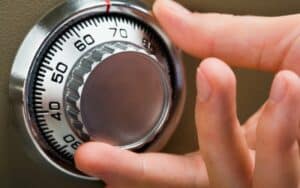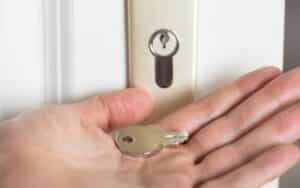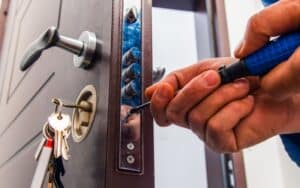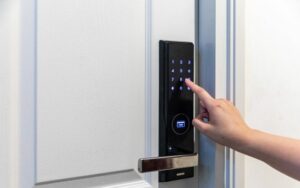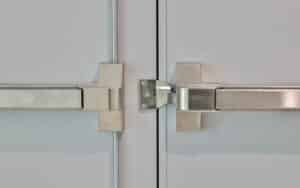Ever found yourself in a pickle because you’ve forgotten the combination to your lock? You’re not alone. Resetting combination locks is a handy skill that’ll save you from a lot of hassle, whether you’re updating your locker security or assigning new codes to employees or students. It’s simpler than you might think, and you won’t need any special skills to get it done.
Got a new 4-digit master lock that needs a fresh start? No worries. With a reset tool and a few easy steps, you’ll have your lock combination updated in no time. It’s all about knowing the right process and having the confidence to do it yourself. Let’s get into how you can regain control and set a new combination that’s memorable for you but tricky for others to crack.
Table of Contents
ToggleUnderstanding Combination Locks
When you’re dealing with the security of your belongings, knowing how your lock mechanisms function can provide an extra layer of reassurance.
How Combination Locks Work
Combination locks are built on the concept of aligning internal components to a unique sequence that allows the lock to open. Here’s a simplified breakdown of the operation:
- Rotating Dials: Each dial in a combination lock is attached to a spindle that turns a drive cam.
- Drive Pins: These pins are connected to the drive cams and make contact with the tabs—or wheel flies—in the lock.
- Wheel Notches: As all dials are turned to the correct combination, the wheel notches align perfectly, allowing the lock to open.
The ingenuity of this mechanism lies in its simple yet secure design. With every additional digit, the possible combinations increase exponentially, enhancing security. For example, by progressing from a 3-digit to a 4-digit lock, the number of unique combinations jumps from 1,000 to 10,000.
Types of Combination Locks
Each variety of combination lock is designed with specific applications in mind. Let’s look at a few common types:
- Single Dial Locks: Think school lockers; these feature a singular dial that turns in alternate directions to input the combination.
- Multiple Dial Locks: Often used for bags and briefcases, these locks come with several dials, each representing a single digit of the combination.
- Electronic Combination Locks: Utilizing a keypad, these require the input of a digital code and offer advanced features such as multiple user codes.
While varying in their operation, all these locks eliminate the need for keys, thereby sidestepping issues such as key loss or duplication. They are suited to a range of applications from school lockers and gates to high-security areas requiring controlled access. Remember, whenever you’re choosing a lock, consider the balance between convenience and the level of security required for your specific needs.

Preparing to Reset the Lock
When you’re looking to reset your combination lock, it’s crucial to start off on the right foot. Proper preparation ensures a smooth process, and there are several key steps you need to take before you begin the actual resetting.
Gather the Necessary Tools
Before you start the reset process, it’s essential to have all the necessary tools on hand. Depending on the specific design of your combination lock, you’ll need:
- Reset Tool or Change Code Key: This may come as a special tool supplied by the manufacturer or you’ll have to improvise with a straightened paper clip or a similar item.
- The Lock’s Instruction Manual: Often overlooked, the instruction manual is your go-to guide for tailored information concerning your lock model.
By gathering these tools beforehand, you’ll avoid any interruption once you start the process.
Choose a Secure Location
Selecting the right place to reset your lock is just as key as the process itself. Here’s why a secure location matters:
- Privacy: Ensure the new combination is set without prying eyes, reducing the risk of unauthorized access.
- Focus: A secure and quiet environment allows you to concentrate, minimizing the chances of errors while setting the new combination.
Make sure the place you pick is somewhere you feel completely at ease to avoid potential complications.
Know the Default Combination
Most locks come with a default combination that is often set to a simple sequence like ‘000’. It’s crucial to know this combination because:
- It’s required to open your lock for the first time.
- You’ll need to use it as a starting point before setting a new code.
The default setting is generally found in the lock’s instruction manual or on a sticker attached to the lock. Ensure you’re aware of this combination before attempting to reset your lock.
Resetting the Combination Lock
Resetting your combination lock is a straightforward process that can refresh security and give you peace of mind. Whether you’re starting anew or updating an existing lock, these steps will ensure that your belongings remain secure.
Clearing the Lock
Before you can set a new combination, it’s essential to clear the current settings from your lock. This is a security measure that prevents previous combinations from interfering with the setting of a new code.
- Locate the reset lever or button typically found on the back or bottom of the lock.
- Ensure the lock is open before attempting to clear the combination.
- If your lock has a shackle, squeeze it firmly twice to ensure it’s ready for resetting.
- Press the reset button or use the control key to turn the reset lever, usually requiring a 90-degree turn in either direction.
Setting a New Combination
Once the lock has been cleared, you’re ready to establish a new combination.
- First, align the dials to a new combination of your choice. Make sure it’s a sequence that’s memorable to you but not easy for others to guess.
- A mix of directions or numbers that avoid common patterns—like sequential or repeated digits—enhances security significantly.
Here’s what you need to do:
- With the reset tool engaged, turn the dials to set your new combination.
- Ensure each dial is set precisely to your desired code to avoid issues.
- Once set, remove the reset tool or return the reset lever to its original position; this will lock in your new combination.
- Test the new combination by closing the lock and attempting to reopen it with the new code.
- If successful, remember to store your new combination in a secure location, like a combination management system or a secure digital vault.
By selecting a complex code and following these instructions carefully, your lock will be ready to secure your valuables once again. Remember, regular updates to your combination can prevent unauthorized access and maintain the integrity of your lock’s security.

Testing the New Combination
Ensuring that your new combination is effective and operates smoothly is crucial to maintaining security and ease of access. Follow these steps to verify the functionality of your lock after you’ve reset it.
Ensuring Proper Functionality
Once you’ve set your new combination, it’s vital to test the lock to ensure it opens and closes as expected. Here’s how you can make sure your lock is functioning properly:
- Close the lock and mix up the dials.
- Input your new combination precisely.
- The lock should open without resistance.
- If it doesn’t open, ensure that each digit is perfectly aligned with the markings.
If the combination lock fails to open, it’s a clear sign that there may have been an issue during the reset process. In this case, repeat the reset steps to ensure you’ve set the combination correctly.
Combination for Success
Resetting your combination lock is straightforward when you follow the right steps. Remember to clear the old combination thoroughly before setting a new one. A secure and memorable code is your key to maintaining the lock’s integrity. Don’t forget to test your new combination several times to ensure it’s working correctly. Should you encounter any hiccups, the professionals at D&L Mobile Locksmiths will be happy to help. With these tips in hand, you’ll have peace of mind knowing your belongings are safely secured behind a lock that only you can access.
Key Takeaways
- Regularly changing your lock’s combination enhances security. Follow the provided steps carefully for your specific lock model
- Resetting the combination is usually a straightforward process.
- In case of forgotten combinations, alternative access methods may be necessary.
- Professional assistance is available if needed.
- Safeguard your new combination and adhere to safety precautions.
- Contact the manufacturer for any support or warranty inquiries.
By following these key takeaways, you can effectively change your lock’s combination for improved security.
FAQs on Resetting Your Lock
Why would I need to reset my lock?
You may need to reset your lock to change the combination code for security reasons or if you’ve forgotten the current code.
Can I reset any type of lock?
The process of resetting a lock’s combination may vary depending on the type and model of the lock. Consult the lock’s manual or manufacturer’s instructions to determine if it’s possible to reset your particular lock.
Can I reset my lock’s combination without professional assistance?
In many cases, resetting a lock’s combination can be done without the need for professional assistance. However, if you encounter difficulties or are unsure about the process, you should seek assistance from a locksmith or contact the lock manufacturer for support.
Always prioritize safety and security when resetting your lock’s combination, and follow the provided instructions closely to ensure the successful completion of the process.


